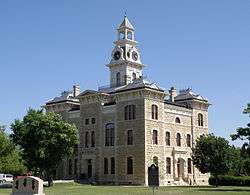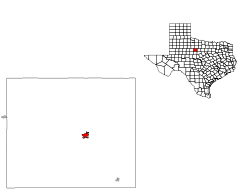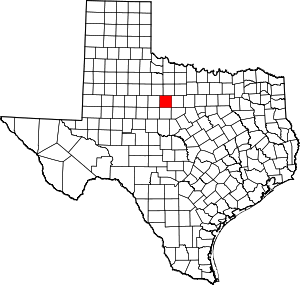Albany, Texas
Albany is a city in Shackelford County, Texas, United States. The population was 2,034 at the 2010 Census. It is the county seat of Shackelford County.[5]
Albany, Texas | |
|---|---|
 | |
Location of Albany, Texas | |
 | |
| Coordinates: 32°43′37″N 99°17′40″W | |
| Country | United States |
| State | Texas |
| County | Shackelford |
| Area | |
| • Total | 1.57 sq mi (4.06 km2) |
| • Land | 1.57 sq mi (4.06 km2) |
| • Water | 0.00 sq mi (0.00 km2) |
| Elevation | 1,414 ft (431 m) |
| Population (2010) | |
| • Total | 2,034 |
| • Estimate (2019)[2] | 1,934 |
| • Density | 1,234.21/sq mi (476.67/km2) |
| Time zone | UTC-6 (Central (CST)) |
| • Summer (DST) | UTC-5 (CDT) |
| ZIP code | 76430 |
| Area code(s) | 325 |
| FIPS code | 48-01648[3] |
| GNIS feature ID | 1329326[4] |
History
Established in 1873, Albany was named by county clerk William Cruger after his former home of Albany, Georgia.
Lieutenant Colonel William Dyess, survivor of the Bataan Death March in the Philippines and namesake of Dyess Air Force Base, was born in Albany on August 9, 1916.[6]
Major General Robert B. Williams, who led the World War II aerial bombing raid on Schweinfurt, Germany, was born in Albany on November 9, 1901.[7]
Geography
Albany is located northeast of Abilene, the seat of Taylor County.
According to the United States Census Bureau, the city has a total area of 1.5 square miles (3.8 km2), all land.
Climate
| Climate data for Albany, Texas | |||||||||||||
|---|---|---|---|---|---|---|---|---|---|---|---|---|---|
| Month | Jan | Feb | Mar | Apr | May | Jun | Jul | Aug | Sep | Oct | Nov | Dec | Year |
| Average high °F (°C) | 57.2 (14.0) |
61.1 (16.2) |
69.5 (20.8) |
78.3 (25.7) |
85.1 (29.5) |
92.6 (33.7) |
96.7 (35.9) |
97.0 (36.1) |
89.5 (31.9) |
79.7 (26.5) |
67.7 (19.8) |
59.0 (15.0) |
77.8 (25.4) |
| Average low °F (°C) | 31.0 (−0.6) |
35.2 (1.8) |
42.3 (5.7) |
50.0 (10.0) |
58.9 (14.9) |
66.7 (19.3) |
70.1 (21.2) |
68.9 (20.5) |
62.0 (16.7) |
51.4 (10.8) |
39.6 (4.2) |
33.1 (0.6) |
50.9 (10.5) |
| Average precipitation inches (mm) | 1.2 (30) |
1.4 (36) |
1.6 (41) |
2.6 (66) |
3.8 (97) |
3.0 (76) |
2.2 (56) |
2.2 (56) |
2.9 (74) |
2.6 (66) |
1.6 (41) |
1.4 (36) |
26.7 (680) |
| Source: Weatherbase [8] | |||||||||||||
Demographics
| Historical population | |||
|---|---|---|---|
| Census | Pop. | %± | |
| 1880 | 129 | — | |
| 1890 | 857 | 564.3% | |
| 1920 | 1,469 | — | |
| 1930 | 2,422 | 64.9% | |
| 1940 | 2,230 | −7.9% | |
| 1950 | 2,241 | 0.5% | |
| 1960 | 2,174 | −3.0% | |
| 1970 | 1,978 | −9.0% | |
| 1980 | 2,450 | 23.9% | |
| 1990 | 1,962 | −19.9% | |
| 2000 | 1,921 | −2.1% | |
| 2010 | 2,034 | 5.9% | |
| Est. 2019 | 1,934 | [2] | −4.9% |
| U.S. Decennial Census[9] | |||
As of the census[3] of 2000, 1,921 people, 746 households, and 531 families resided in the city. The population density was 1,305.9 people per square mile (504.6/km2). The 880 housing units averaged 598.2 per square mile (231.1/km2). The racial makeup of the city was 93.13% White, 0.68% African American, 0.47% Native American, 4.84% from other races, and 0.88% from two or more races. Hispanics or Latinos of any race were 8.07% of the population.
Of the 746 households, 33.1% had children under the age of 18 living with them, 59.1% were married couples living together, 8.7% had a female householder with no husband present, and 28.7% were not families. Of all households, 27.3% were made up of individuals, and 16.1% had someone living alone who was 65 years of age or older. The average household size was 2.51 and the average family size was 3.08.
In the city, the population was distributed as 27.0% under the age of 18, 6.4% from 18 to 24, 25.4% from 25 to 44, 23.0% from 45 to 64, and 18.3% who were 65 years of age or older. The median age was 39 years. For every 100 females, there were 86.9 males. For every 100 females age 18 and over, there were 83.2 males.
The median income for a household in the city was $31,563, and for a family was $40,592. Males had a median income of $28,846 versus $17,411 for females. The per capita income for the city was $17,470. About 8.1% of families and 9.2% of the population were below the poverty line, including 10.1% of those under age 18 and 11.1% of those age 65 or over.
Schools
Albany is served by the Albany Independent School District. Their mascot is the Lion and their school colors are red and white.
- Nancy Smith Elementary (Grades PK–6)
- 2006 National Blue Ribbon School [10]
- Albany Junior/Senior High School (Grades 7–12)
Fort Griffin Fandangle
Since 1938, Texas' oldest outdoor musical, the Fort Griffin Fandangle, has been presented during the last two weekends of June in the Prairie Theater about historic Fort Griffin, a military outpost established in 1867 near Albany and now a state park. The program, the content of which is different each year, attempts to recapture the theatrical charm of the American West.
The show offers covered wagons and buggies, a stagecoach, a replica of the first Texas Central Railroad train, an oil derrick, and cowboys whose ancestors pushed Longhorn herds up the nearby Great Western Cattle Trail. The Dallas Morning News describes Fandangle, accordingly: "as professional as a multimillion dollar Broadway musical, with sets and costumes to match, with a cast of three hundred". The Abilene Reporter-News calls the program "Frontier history served up with genuine earthiness, spiced by rare humor."[11]
References
- "2019 U.S. Gazetteer Files". United States Census Bureau. Retrieved August 7, 2020.
- "Population and Housing Unit Estimates". United States Census Bureau. May 24, 2020. Retrieved May 27, 2020.
- "U.S. Census website". United States Census Bureau. Retrieved 2008-01-31.
- "US Board on Geographic Names". United States Geological Survey. 2007-10-25. Retrieved 2008-01-31.
- "Find a County". National Association of Counties. Archived from the original on 2011-05-31. Retrieved 2011-06-07.
- Martine Anderson. "William Edwin Dyess". The Handbook of Texas Online. Texas State Historical Association. Retrieved 2010-04-01.
- "Major General Robert B. Williams". U.S. Air Force Official Website. U.S. Air Force. Archived from the original on 14 April 2010. Retrieved 2010-03-31.
- "Weatherbase: Historical Weather for Albany, Texas". Weatherbase. 2011. Retrieved on November 24, 2011.
- "Census of Population and Housing". Census.gov. Retrieved June 4, 2015.
- Blue Ribbon School list
- "Fort Griffin Fandangle", Albany, Texas, brochure: www.fortgrigginfandangle.org
External links
| Wikimedia Commons has media related to Albany, Texas. |

